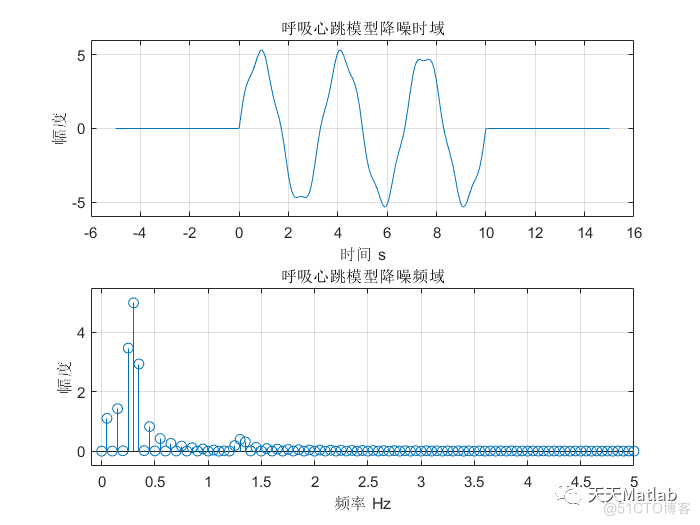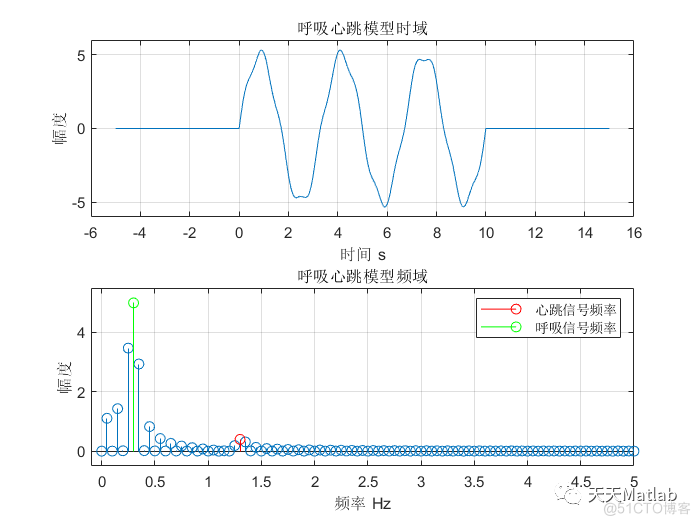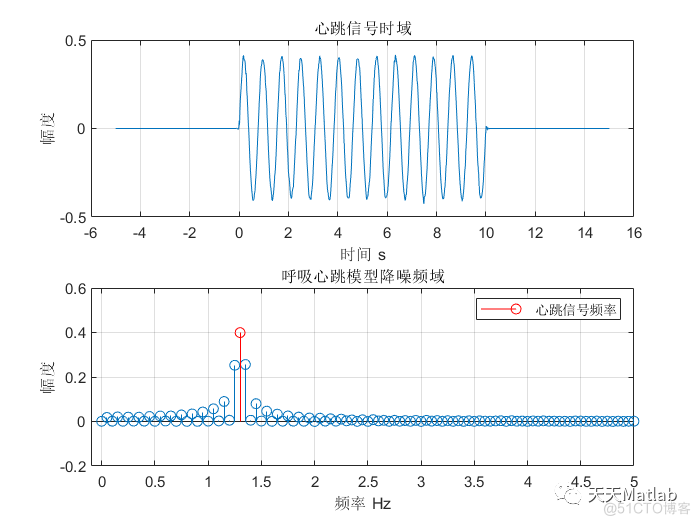✅作者简介:热爱科研的Matlab仿真开发者,修心和技术同步精进,matlab项目合作可私信。
🍎个人主页:Matlab科研工作室
🍊个人信条:格物致知。
更多Matlab仿真内容点击👇
⛄ 内容介绍
❤️ EMD
经验模态分解(Empirical Mode Decomposition,EMD)法是黄锷(N. E. Huang)在美国国家宇航局与其他人于1998年创造性地提出的一种新型自适应信号时频处理方法,特别适用于非线性非平稳信号的分析处理。它是一种适用于处理非平稳非线性序列的自适应的时空分析方法。EMD进行了操作,将一个序列分成数个“模态”(IMFs, 本征模态函数)而不偏离时间域。这可以与一些时空分析方法,如傅里叶变换和小波分解,相比拟。与这些方法类似,EMD并不基于物理(原理)。相反,这些模态可能提供了在这些数据中包含了众多的信号。这个方法尤其适用于分析自然信号,而自然信号通常是非线性和非平稳的。一些典型的例子包括南方涛动指数(SOI),NINO-3.4指数,等。
过程
- EMD将原始信号分解成本征模态函数(IMF)分量
- 一个本征模态函数是:
1. 在过零点直接仅有一个极值
2. 均值为零为了描述这一过程,我们借用海报下面的部分:
筛选过程 - 筛选过程就是EMD用于将信号分解成IMF的过程。
筛选过程如下:
对于一个信号X(t),从三次样条插值的局地最大值和最小值确定上下包络,让m1表示上下包络的均值。局地性是由任意参数确定;计算时间和EMD的有效性很大程度上取决于这个参数。 - 第一个分量h1计算方法如下:
h1=X(t)-m1 - 在第二个筛选过程中,h1被视作数据,m11是h1的上下包络的均值:
h11=h1-m11 - 筛选过程重复k次,知道h1k是一个本征模态函数,即:
h1(k-1)-m1k=h1k - 随后它被指定为c1=h1k,数据中第一个IMF分量,它包含了信号中最短的周期分量。我们将它从数据剩余部分中分离:X(t)-c1 = r1 这个过程重复rj次:r1-c2 = r2,....,rn-1 - cn = rn
- 结果是一组函数;在集合中函数的数目依赖与原始信号。
❤️ CEEMDAN
CEEMDAN,全名Complete Ensemble Empirical Mode Decomposition with Adaptive Noise Analysis,意为“利用自适应噪声分析进行的完全的集合经验模态分解”,要注意这个方法并不是在CEEMD方法上改进而来的,而是从EMD的基础上加以改进,同时借用了EEMD方法中加入高斯噪声和通过多次叠加并平均以抵消噪声的思想。
⛄ 部分代码
%EMD computes Empirical Mode Decomposition
%
%
% Syntax
%
%
% IMF = EMD(X)
% IMF = EMD(X,...,'Option_name',Option_value,...)
% IMF = EMD(X,OPTS)
% [IMF,ORT,NB_ITERATIONS] = EMD(...)
%
%
% Description
%
%
% IMF = EMD(X) where X is a real vector computes the Empirical Mode
% Decomposition [1] of X, resulting in a matrix IMF containing 1 IMF per row, the
% last one being the residue. The default stopping criterion is the one proposed
% in [2]:
%
% at each point, mean_amplitude < THRESHOLD2*envelope_amplitude
% &
% mean of boolean array {(mean_amplitude)/(envelope_amplitude) > THRESHOLD} < TOLERANCE
% &
% |#zeros-#extrema|<=1
%
% where mean_amplitude = abs(envelope_max+envelope_min)/2
% and envelope_amplitude = abs(envelope_max-envelope_min)/2
%
% IMF = EMD(X) where X is a complex vector computes Bivariate Empirical Mode
% Decomposition [3] of X, resulting in a matrix IMF containing 1 IMF per row, the
% last one being the residue. The default stopping criterion is similar to the
% one proposed in [2]:
%
% at each point, mean_amplitude < THRESHOLD2*envelope_amplitude
% &
% mean of boolean array {(mean_amplitude)/(envelope_amplitude) > THRESHOLD} < TOLERANCE
%
% where mean_amplitude and envelope_amplitude have definitions similar to the
% real case
%
% IMF = EMD(X,...,'Option_name',Option_value,...) sets options Option_name to
% the specified Option_value (see Options)
%
% IMF = EMD(X,OPTS) is equivalent to the above syntax provided OPTS is a struct
% object with field names corresponding to option names and field values being the
% associated values
%
% [IMF,ORT,NB_ITERATIONS] = EMD(...) returns an index of orthogonality
% ________
% _ |IMF(i,:).*IMF(j,:)|
% ORT = \ _____________________
% /
% � || X ||�
% i~=j
%
% and the number of iterations to extract each mode in NB_ITERATIONS
%
%
% Options
%
%
% stopping criterion options:
%
% STOP: vector of stopping parameters [THRESHOLD,THRESHOLD2,TOLERANCE]
% if the input vector's length is less than 3, only the first parameters are
% set, the remaining ones taking default values.
% default: [0.05,0.5,0.05]
%
% FIX (int): disable the default stopping criterion and do exactly <FIX>
% number of sifting iterations for each mode
%
% FIX_H (int): disable the default stopping criterion and do <FIX_H> sifting
% iterations with |#zeros-#extrema|<=1 to stop [4]
%
% bivariate/complex EMD options:
%
% COMPLEX_VERSION: selects the algorithm used for complex EMD ([3])
% COMPLEX_VERSION = 1: "algorithm 1"
% COMPLEX_VERSION = 2: "algorithm 2" (default)
%
% NDIRS: number of directions in which envelopes are computed (default 4)
% rem: the actual number of directions (according to [3]) is 2*NDIRS
%
% other options:
%
% T: sampling times (line vector) (default: 1:length(x))
%
% MAXITERATIONS: maximum number of sifting iterations for the computation of each
% mode (default: 2000)
%
% MAXMODES: maximum number of imfs extracted (default: Inf)
%
% DISPLAY: if equals to 1 shows sifting steps with pause
% if equals to 2 shows sifting steps without pause (movie style)
% rem: display is disabled when the input is complex
%
% INTERP: interpolation scheme: 'linear', 'cubic', 'pchip' or 'spline' (default)
% see interp1 documentation for details
%
% MASK: masking signal used to improve the decomposition according to [5]
%
%
% Examples
%
%
%X = rand(1,512);
%
%IMF = emd(X);
%
%IMF = emd(X,'STOP',[0.1,0.5,0.05],'MAXITERATIONS',100);
%
%T=linspace(0,20,1e3);
%X = 2*exp(i*T)+exp(3*i*T)+.5*T;
%IMF = emd(X,'T',T);
%
%OPTIONS.DISLPAY = 1;
%OPTIONS.FIX = 10;
%OPTIONS.MAXMODES = 3;
%[IMF,ORT,NBITS] = emd(X,OPTIONS);
%
%
% References
%
%
% [1] N. E. Huang et al., "The empirical mode decomposition and the
% Hilbert spectrum for non-linear and non stationary time series analysis",
% Proc. Royal Soc. London A, Vol. 454, pp. 903-995, 1998
%
% [2] G. Rilling, P. Flandrin and P. Gon鏰lves
% "On Empirical Mode Decomposition and its algorithms",
% IEEE-EURASIP Workshop on Nonlinear Signal and Image Processing
% NSIP-03, Grado (I), June 2003
%
% [3] G. Rilling, P. Flandrin, P. Gon鏰lves and J. M. Lilly.,
% "Bivariate Empirical Mode Decomposition",
% Signal Processing Letters (submitted)
%
% [4] N. E. Huang et al., "A confidence limit for the Empirical Mode
% Decomposition and Hilbert spectral analysis",
% Proc. Royal Soc. London A, Vol. 459, pp. 2317-2345, 2003
%
% [5] R. Deering and J. F. Kaiser, "The use of a masking signal to improve
% empirical mode decomposition", ICASSP 2005
%
%
% See also
% emd_visu (visualization),
% emdc, emdc_fix (fast implementations of EMD),
% cemdc, cemdc_fix, cemdc2, cemdc2_fix (fast implementations of bivariate EMD),
% hhspectrum (Hilbert-Huang spectrum)
%
%
% G. Rilling, last modification: 3.2007
% gabriel.rilling@ens-lyon.fr
function [imf,ort,nbits] = emd_auto(varargin)
[x,t,sd,sd2,tol,MODE_COMPLEX,ndirs,display_sifting,sdt,sd2t,r,imf,k,nbit,NbIt,MAXITERATIONS,FIXE,FIXE_H,MAXMODES,INTERP,mask] = init(varargin{:});
if display_sifting
fig_h = figure;
end
%main loop : requires at least 3 extrema to proceed
while (~stop_EMD(r,MODE_COMPLEX,ndirs) && (k < MAXMODES+1 || MAXMODES == 0) && ~any(mask))
% current mode
m = r;
% mode at previous iteration
mp = m;
%computation of mean and stopping criterion
if FIXE
[stop_sift,moyenne] = stop_sifting_fixe(t,m,INTERP,MODE_COMPLEX,ndirs);
elseif FIXE_H
stop_count = 0;
[stop_sift,moyenne] = stop_sifting_fixe_h(t,m,INTERP,stop_count,FIXE_H,MODE_COMPLEX,ndirs);
else
[stop_sift,moyenne] = stop_sifting(m,t,sd,sd2,tol,INTERP,MODE_COMPLEX,ndirs);
end
% in case the current mode is so small that machine precision can cause
% spurious extrema to appear
if (max(abs(m))) < (1e-10)*(max(abs(x)))
if ~stop_sift
warning('emd:warning','forced stop of EMD : too small amplitude')
else
disp('forced stop of EMD : too small amplitude')
end
break
end
% sifting loop
while ~stop_sift && nbit<MAXITERATIONS
if(~MODE_COMPLEX && nbit>MAXITERATIONS/5 && mod(nbit,floor(MAXITERATIONS/10))==0 && ~FIXE && nbit > 100)
disp(['mode ',int2str(k),', iteration ',int2str(nbit)])
if exist('s','var')
disp(['stop parameter mean value : ',num2str(s)])
end
[im,iM] = extr(m);
disp([int2str(sum(m(im) > 0)),' minima > 0; ',int2str(sum(m(iM) < 0)),' maxima < 0.'])
end
%sifting
m = m - moyenne;
%computation of mean and stopping criterion
if FIXE
[stop_sift,moyenne] = stop_sifting_fixe(t,m,INTERP,MODE_COMPLEX,ndirs);
elseif FIXE_H
[stop_sift,moyenne,stop_count] = stop_sifting_fixe_h(t,m,INTERP,stop_count,FIXE_H,MODE_COMPLEX,ndirs);
else
[stop_sift,moyenne,s] = stop_sifting(m,t,sd,sd2,tol,INTERP,MODE_COMPLEX,ndirs);
end
% display
if display_sifting && ~MODE_COMPLEX
NBSYM = 2;
[indmin,indmax] = extr(mp);
[tmin,tmax,mmin,mmax] = boundary_conditions(indmin,indmax,t,mp,mp,NBSYM);
envminp = interp1(tmin,mmin,t,INTERP);
envmaxp = interp1(tmax,mmax,t,INTERP);
envmoyp = (envminp+envmaxp)/2;
if FIXE || FIXE_H
display_emd_fixe(t,m,mp,r,envminp,envmaxp,envmoyp,nbit,k,display_sifting)
else
sxp=2*(abs(envmoyp))./(abs(envmaxp-envminp));
sp = mean(sxp);
display_emd(t,m,mp,r,envminp,envmaxp,envmoyp,s,sp,sxp,sdt,sd2t,nbit,k,display_sifting,stop_sift)
end
end
mp = m;
nbit=nbit+1;
NbIt=NbIt+1;
if(nbit==(MAXITERATIONS-1) && ~FIXE && nbit > 100)
if exist('s','var')
warning('emd:warning',['forced stop of sifting : too many iterations... mode ',int2str(k),'. stop parameter mean value : ',num2str(s)])
else
warning('emd:warning',['forced stop of sifting : too many iterations... mode ',int2str(k),'.'])
end
end
end % sifting loop
imf(k,:) = m;
if display_sifting
disp(['mode ',int2str(k),' stored'])
end
nbits(k) = nbit;
k = k+1;
r = r - m;
nbit=0;
end %main loop
if any(r) && ~any(mask)
imf(k,:) = r;
end
ort = io(x,imf);
if display_sifting
close
end
end
%---------------------------------------------------------------------------------------------------
% tests if there are enough (3) extrema to continue the decomposition
function stop = stop_EMD(r,MODE_COMPLEX,ndirs)
if MODE_COMPLEX
for k = 1:ndirs
phi = (k-1)*pi/ndirs;
[indmin,indmax] = extr(real(exp(i*phi)*r));
ner(k) = length(indmin) + length(indmax);
end
stop = any(ner < 3);
else
[indmin,indmax] = extr(r);
ner = length(indmin) + length(indmax);
stop = ner < 3;
end
end
%---------------------------------------------------------------------------------------------------
% computes the mean of the envelopes and the mode amplitude estimate
function [envmoy,nem,nzm,amp] = mean_and_amplitude(m,t,INTERP,MODE_COMPLEX,ndirs)
NBSYM = 2;
if MODE_COMPLEX
switch MODE_COMPLEX
case 1
for k = 1:ndirs
phi = (k-1)*pi/ndirs;
y = real(exp(-i*phi)*m);
[indmin,indmax,indzer] = extr(y);
nem(k) = length(indmin)+length(indmax);
nzm(k) = length(indzer);
[tmin,tmax,zmin,zmax] = boundary_conditions(indmin,indmax,t,y,m,NBSYM);
envmin(k,:) = interp1(tmin,zmin,t,INTERP);
envmax(k,:) = interp1(tmax,zmax,t,INTERP);
end
envmoy = mean((envmin+envmax)/2,1);
if nargout > 3
amp = mean(abs(envmax-envmin),1)/2;
end
case 2
for k = 1:ndirs
phi = (k-1)*pi/ndirs;
y = real(exp(-i*phi)*m);
[indmin,indmax,indzer] = extr(y);
nem(k) = length(indmin)+length(indmax);
nzm(k) = length(indzer);
[tmin,tmax,zmin,zmax] = boundary_conditions(indmin,indmax,t,y,y,NBSYM);
envmin(k,:) = exp(i*phi)*interp1(tmin,zmin,t,INTERP);
envmax(k,:) = exp(i*phi)*interp1(tmax,zmax,t,INTERP);
end
envmoy = mean((envmin+envmax),1);
if nargout > 3
amp = mean(abs(envmax-envmin),1)/2;
end
end
else
[indmin,indmax,indzer] = extr(m);
nem = length(indmin)+length(indmax);
nzm = length(indzer);
[tmin,tmax,mmin,mmax] = boundary_conditions(indmin,indmax,t,m,m,NBSYM);
envmin = interp1(tmin,mmin,t,INTERP);
envmax = interp1(tmax,mmax,t,INTERP);
envmoy = (envmin+envmax)/2;
if nargout > 3
amp = mean(abs(envmax-envmin),1)/2;
end
end
end
%-------------------------------------------------------------------------------
% default stopping criterion
function [stop,envmoy,s] = stop_sifting(m,t,sd,sd2,tol,INTERP,MODE_COMPLEX,ndirs)
try
[envmoy,nem,nzm,amp] = mean_and_amplitude(m,t,INTERP,MODE_COMPLEX,ndirs);
sx = abs(envmoy)./amp;
s = mean(sx);
stop = ~((mean(sx > sd) > tol | any(sx > sd2)) & (all(nem > 2)));
if ~MODE_COMPLEX
stop = stop && ~(abs(nzm-nem)>1);
end
catch
stop = 1;
envmoy = zeros(1,length(m));
s = NaN;
end
end
%-------------------------------------------------------------------------------
% stopping criterion corresponding to option FIX
function [stop,moyenne]= stop_sifting_fixe(t,m,INTERP,MODE_COMPLEX,ndirs)
try
moyenne = mean_and_amplitude(m,t,INTERP,MODE_COMPLEX,ndirs);
stop = 0;
catch
moyenne = zeros(1,length(m));
stop = 1;
end
end
%-------------------------------------------------------------------------------
% stopping criterion corresponding to option FIX_H
function [stop,moyenne,stop_count]= stop_sifting_fixe_h(t,m,INTERP,stop_count,FIXE_H,MODE_COMPLEX,ndirs)
try
[moyenne,nem,nzm] = mean_and_amplitude(m,t,INTERP,MODE_COMPLEX,ndirs);
if (all(abs(nzm-nem)>1))
stop = 0;
stop_count = 0;
else
stop_count = stop_count+1;
stop = (stop_count == FIXE_H);
end
catch
moyenne = zeros(1,length(m));
stop = 1;
end
end
%-------------------------------------------------------------------------------
% displays the progression of the decomposition with the default stopping criterion
function display_emd(t,m,mp,r,envmin,envmax,envmoy,s,sb,sx,sdt,sd2t,nbit,k,display_sifting,stop_sift)
subplot(4,1,1)
plot(t,mp);hold on;
plot(t,envmax,'--k');plot(t,envmin,'--k');plot(t,envmoy,'r');
title(['IMF ',int2str(k),'; iteration ',int2str(nbit),' before sifting']);
set(gca,'XTick',[])
hold off
subplot(4,1,2)
plot(t,sx)
hold on
plot(t,sdt,'--r')
plot(t,sd2t,':k')
title('stop parameter')
set(gca,'XTick',[])
hold off
subplot(4,1,3)
plot(t,m)
title(['IMF ',int2str(k),'; iteration ',int2str(nbit),' after sifting']);
set(gca,'XTick',[])
subplot(4,1,4);
plot(t,r-m)
title('residue');
disp(['stop parameter mean value : ',num2str(sb),' before sifting and ',num2str(s),' after'])
if stop_sift
disp('last iteration for this mode')
end
if display_sifting == 2
pause(0.01)
else
pause
end
end
%---------------------------------------------------------------------------------------------------
% displays the progression of the decomposition with the FIX and FIX_H stopping criteria
function display_emd_fixe(t,m,mp,r,envmin,envmax,envmoy,nbit,k,display_sifting)
subplot(3,1,1)
plot(t,mp);hold on;
plot(t,envmax,'--k');plot(t,envmin,'--k');plot(t,envmoy,'r');
title(['IMF ',int2str(k),'; iteration ',int2str(nbit),' before sifting']);
set(gca,'XTick',[])
hold off
subplot(3,1,2)
plot(t,m)
title(['IMF ',int2str(k),'; iteration ',int2str(nbit),' after sifting']);
set(gca,'XTick',[])
subplot(3,1,3);
plot(t,r-m)
title('residue');
if display_sifting == 2
pause(0.01)
else
pause
end
end
%---------------------------------------------------------------------------------------
% defines new extrema points to extend the interpolations at the edges of the
% signal (mainly mirror symmetry)
function [tmin,tmax,zmin,zmax] = boundary_conditions(indmin,indmax,t,x,z,nbsym)
lx = length(x);
if (length(indmin) + length(indmax) < 3)
error('not enough extrema')
end
% boundary conditions for interpolations :
if indmax(1) < indmin(1)
if x(1) > x(indmin(1))
lmax = fliplr(indmax(2:min(end,nbsym+1)));
lmin = fliplr(indmin(1:min(end,nbsym)));
lsym = indmax(1);
else
lmax = fliplr(indmax(1:min(end,nbsym)));
lmin = [fliplr(indmin(1:min(end,nbsym-1))),1];
lsym = 1;
end
else
if x(1) < x(indmax(1))
lmax = fliplr(indmax(1:min(end,nbsym)));
lmin = fliplr(indmin(2:min(end,nbsym+1)));
lsym = indmin(1);
else
lmax = [fliplr(indmax(1:min(end,nbsym-1))),1];
lmin = fliplr(indmin(1:min(end,nbsym)));
lsym = 1;
end
end
if indmax(end) < indmin(end)
if x(end) < x(indmax(end))
rmax = fliplr(indmax(max(end-nbsym+1,1):end));
rmin = fliplr(indmin(max(end-nbsym,1):end-1));
rsym = indmin(end);
else
rmax = [lx,fliplr(indmax(max(end-nbsym+2,1):end))];
rmin = fliplr(indmin(max(end-nbsym+1,1):end));
rsym = lx;
end
else
if x(end) > x(indmin(end))
rmax = fliplr(indmax(max(end-nbsym,1):end-1));
rmin = fliplr(indmin(max(end-nbsym+1,1):end));
rsym = indmax(end);
else
rmax = fliplr(indmax(max(end-nbsym+1,1):end));
rmin = [lx,fliplr(indmin(max(end-nbsym+2,1):end))];
rsym = lx;
end
end
tlmin = 2*t(lsym)-t(lmin);
tlmax = 2*t(lsym)-t(lmax);
trmin = 2*t(rsym)-t(rmin);
trmax = 2*t(rsym)-t(rmax);
% in case symmetrized parts do not extend enough
if tlmin(1) > t(1) || tlmax(1) > t(1)
if lsym == indmax(1)
lmax = fliplr(indmax(1:min(end,nbsym)));
else
lmin = fliplr(indmin(1:min(end,nbsym)));
end
if lsym == 1
error('bug')
end
lsym = 1;
tlmin = 2*t(lsym)-t(lmin);
tlmax = 2*t(lsym)-t(lmax);
end
if trmin(end) < t(lx) || trmax(end) < t(lx)
if rsym == indmax(end)
rmax = fliplr(indmax(max(end-nbsym+1,1):end));
else
rmin = fliplr(indmin(max(end-nbsym+1,1):end));
end
if rsym == lx
error('bug')
end
rsym = lx;
trmin = 2*t(rsym)-t(rmin);
trmax = 2*t(rsym)-t(rmax);
end
zlmax =z(lmax);
zlmin =z(lmin);
zrmax =z(rmax);
zrmin =z(rmin);
tmin = [tlmin t(indmin) trmin];
tmax = [tlmax t(indmax) trmax];
zmin = [zlmin z(indmin) zrmin];
zmax = [zlmax z(indmax) zrmax];
end
%---------------------------------------------------------------------------------------------------
%extracts the indices of extrema
function [indmin, indmax, indzer] = extr(x,t)
if(nargin==1)
t=1:length(x);
end
m = length(x);
if nargout > 2
x1=x(1:m-1);
x2=x(2:m);
indzer = find(x1.*x2<0);
if any(x == 0)
iz = find( x==0 );
indz = [];
if any(diff(iz)==1)
zer = x == 0;
dz = diff([0 zer 0]);
debz = find(dz == 1);
finz = find(dz == -1)-1;
indz = round((debz+finz)/2);
else
indz = iz;
end
indzer = sort([indzer indz]);
end
end
d = diff(x);
n = length(d);
d1 = d(1:n-1);
d2 = d(2:n);
indmin = find(d1.*d2<0 & d1<0)+1;
indmax = find(d1.*d2<0 & d1>0)+1;
% when two or more successive points have the same value we consider only one extremum in the middle of the constant area
% (only works if the signal is uniformly sampled)
if any(d==0)
imax = [];
imin = [];
bad = (d==0);
dd = diff([0 bad 0]);
debs = find(dd == 1);
fins = find(dd == -1);
if debs(1) == 1
if length(debs) > 1
debs = debs(2:end);
fins = fins(2:end);
else
debs = [];
fins = [];
end
end
if length(debs) > 0
if fins(end) == m
if length(debs) > 1
debs = debs(1:(end-1));
fins = fins(1:(end-1));
else
debs = [];
fins = [];
end
end
end
lc = length(debs);
if lc > 0
for k = 1:lc
if d(debs(k)-1) > 0
if d(fins(k)) < 0
imax = [imax round((fins(k)+debs(k))/2)];
end
else
if d(fins(k)) > 0
imin = [imin round((fins(k)+debs(k))/2)];
end
end
end
end
if length(imax) > 0
indmax = sort([indmax imax]);
end
if length(imin) > 0
indmin = sort([indmin imin]);
end
end
end
%---------------------------------------------------------------------------------------------------
function ort = io(x,imf)
% ort = IO(x,imf) computes the index of orthogonality
%
% inputs : - x : analyzed signal
% - imf : empirical mode decomposition
n = size(imf,1);
s = 0;
for i = 1:n
for j =1:n
if i~=j
s = s + abs(sum(imf(i,:).*conj(imf(j,:)))/sum(x.^2));
end
end
end
ort = 0.5*s;
end
%---------------------------------------------------------------------------------------------------
function [x,t,sd,sd2,tol,MODE_COMPLEX,ndirs,display_sifting,sdt,sd2t,r,imf,k,nbit,NbIt,MAXITERATIONS,FIXE,FIXE_H,MAXMODES,INTERP,mask] = init(varargin)
x = varargin{1};
if nargin == 2
if isstruct(varargin{2})
inopts = varargin{2};
else
error('when using 2 arguments the first one is the analyzed signal X and the second one is a struct object describing the options')
end
elseif nargin > 2
try
inopts = struct(varargin{2:end});
catch
error('bad argument syntax')
end
end
% default for stopping
defstop = [0.05,0.5,0.05];
opt_fields = {'t','stop','display','maxiterations','fix','maxmodes','interp','fix_h','mask','ndirs','complex_version'};
defopts.stop = defstop;
defopts.display = 0;
defopts.t = 1:max(size(x));
defopts.maxiterations = 2000;
defopts.fix = 0;
defopts.maxmodes = 0;
defopts.interp = 'spline';
defopts.fix_h = 0;
defopts.mask = 0;
defopts.ndirs = 4;
defopts.complex_version = 2;
opts = defopts;
if(nargin==1)
inopts = defopts;
elseif nargin == 0
error('not enough arguments')
end
names = fieldnames(inopts);
for nom = names'
if ~any(strcmpi(char(nom), opt_fields))
error(['bad option field name: ',char(nom)])
end
if ~isempty(eval(['inopts.',char(nom)])) % empty values are discarded
eval(['opts.',lower(char(nom)),' = inopts.',char(nom),';'])
end
end
t = opts.t;
stop = opts.stop;
display_sifting = opts.display;
MAXITERATIONS = opts.maxiterations;
FIXE = opts.fix;
MAXMODES = opts.maxmodes;
INTERP = opts.interp;
FIXE_H = opts.fix_h;
mask = opts.mask;
ndirs = opts.ndirs;
complex_version = opts.complex_version;
if ~isvector(x)
error('X must have only one row or one column')
end
if size(x,1) > 1
x = x.';
end
if ~isvector(t)
error('option field T must have only one row or one column')
end
if ~isreal(t)
error('time instants T must be a real vector')
end
if size(t,1) > 1
t = t';
end
if (length(t)~=length(x))
error('X and option field T must have the same length')
end
if ~isvector(stop) || length(stop) > 3
error('option field STOP must have only one row or one column of max three elements')
end
if ~all(isfinite(x))
error('data elements must be finite')
end
if size(stop,1) > 1
stop = stop';
end
L = length(stop);
if L < 3
stop(3)=defstop(3);
end
if L < 2
stop(2)=defstop(2);
end
if ~ischar(INTERP) || ~any(strcmpi(INTERP,{'linear','cubic','spline'}))
error('INTERP field must be ''linear'', ''cubic'', ''pchip'' or ''spline''')
end
%special procedure when a masking signal is specified
if any(mask)
if ~isvector(mask) || length(mask) ~= length(x)
error('masking signal must have the same dimension as the analyzed signal X')
end
if size(mask,1) > 1
mask = mask.';
end
opts.mask = 0;
imf1 = emd_auto(x+mask,opts);
imf2 = emd_auto(x-mask,opts);
if size(imf1,1) ~= size(imf2,1)
warning('emd:warning',['the two sets of IMFs have different sizes: ',int2str(size(imf1,1)),' and ',int2str(size(imf2,1)),' IMFs.'])
end
S1 = size(imf1,1);
S2 = size(imf2,1);
if S1 ~= S2
if S1 < S2
tmp = imf1;
imf1 = imf2;
imf2 = tmp;
end
imf2(max(S1,S2),1) = 0;
end
imf = (imf1+imf2)/2;
end
sd = stop(1);
sd2 = stop(2);
tol = stop(3);
lx = length(x);
sdt = sd*ones(1,lx);
sd2t = sd2*ones(1,lx);
if FIXE
MAXITERATIONS = FIXE;
if FIXE_H
error('cannot use both ''FIX'' and ''FIX_H'' modes')
end
end
MODE_COMPLEX = ~isreal(x)*complex_version;
if MODE_COMPLEX && complex_version ~= 1 && complex_version ~= 2
error('COMPLEX_VERSION parameter must equal 1 or 2')
end
% number of extrema and zero-crossings in residual
ner = lx;
nzr = lx;
r = x;
if ~any(mask) % if a masking signal is specified "imf" already exists at this stage
imf = [];
end
k = 1;
% iterations counter for extraction of 1 mode
nbit=0;
% total iterations counter
NbIt=0;
end
%---------------------------------------------------------------------------------------------------
⛄ 运行结果





⛄ 参考文献
[1]张喜红, 王玉香. 基于EMD算法的心电信号基线漂移去除方法研究[J]. 重庆科技学院学报:自然科学版, 2016(2):3.
[2]张培玲、李小真、崔帅华. 基于改进小波阈值-CEEMDAN算法的ECG信号去噪研究[J]. 计算机工程与科学, 2020, 42(11):6.





















 432
432











 被折叠的 条评论
为什么被折叠?
被折叠的 条评论
为什么被折叠?










